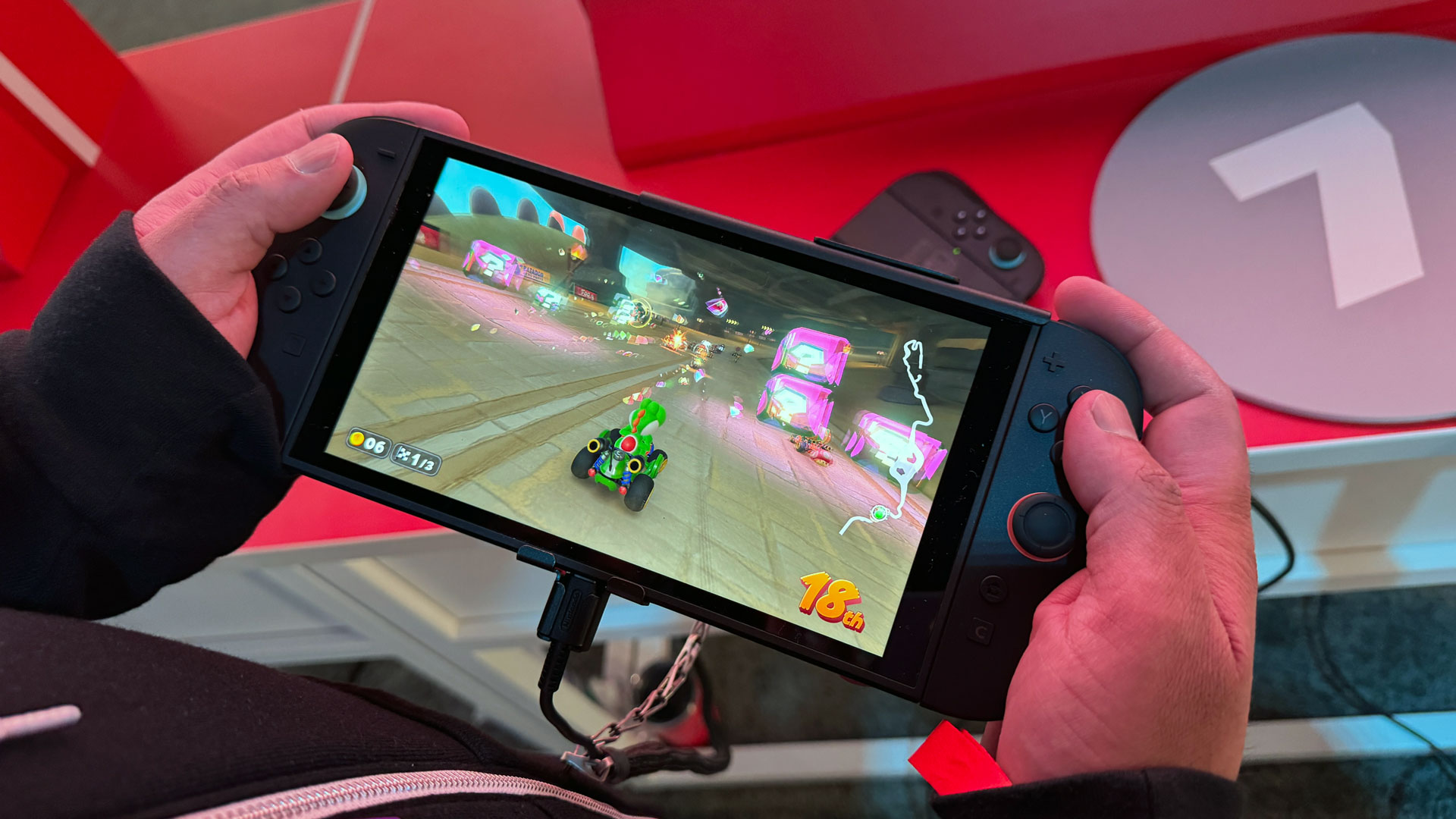Nintendo Switch 2 official specs confirm GPU similar to a mobile RTX 2050
Switch 2 will feature GPU based on Nvidia's Ampere architecture.

Leaked hardware specifications of the upcoming Nintendo Switch 2 have been circulating for a while, but we now have official confirmation of the new console's specs. Digital Foundry has claims it has officially confirmed that the Switch 2 will feature a custom Nvidia SoC with an Ampere-based GPU, 12GB of memory, and 256GB of storage.
The CPU portion of the custom SoC sports eight ARM Cortex A78C cores, featuring the ARMv8 64-bit instruction set and cryptography extensions. Feeding the cores are four cache layers: a 64KB L1 instruction cache, a 64KB L1 data cache, 256KB of L2 cache per core, and 4MB of L3 cache that is shared among all eight cores.
Digital Foundry clarified that six of the CPU cores will be available for games, while two will be strictly reserved for the operating system. This isn't new; it's a method used in the current Switch as well as in other modern consoles, such as the PS5. The CPU has an official maximum clock speed of 1.7 GHz; however, for the Switch 2, the developers have opted to run the CPU at a significantly lower speed: 1.1 GHz in "portable" mode and 0.998 GHz in "docked" mode. (That is not a typo; the CPU operates at a lower clock speed when docked, for unknown reasons.)
The GPU portion of the SoC is based on Nvidia's two-generation-old Ampere architecture and sports 1,536 CUDA cores. The physical chip itself is rated for up to 1,400 MHz, but — similar to the CPU — Nintendo has opted to run the chip at significantly lower speeds on the Switch 2. In "portable" mode, the chip will operate at 561 MHz, and in "docked" mode, 1,007 MHz. The Switch 2's Ampere GPU resembles Nvidia's RTX 3050 and RTX 2050 mobile GPUs (the latter of which is also Ampere-based). Compared to these GPUs, the Switch 2's counterpart has 512 fewer CUDA cores (2,048 vs 1,536) and runs at significantly lower clock speeds.
Adding Ampere to the Switch 2 will give the console real-time ray-tracing capabilities and DLSS support. Nintendo has not announced any games with real-time ray-tracing capabilities, but Digital Foundry and other outlets have demonstrated that it is possible on the RTX 2050 mobile. By contrast, several games have been confirmed to be coming with DLSS support, with Cyberpunk 2077 in particular offering variable real-time resolution scaling with DLSS (a feature of DLSS that is exceptionally rare to see, even on PC).
The memory subsystem is powered by two 6GB LPDDR5X memory modules (12GB total) operating on a 128-bit memory interface. The chips themselves operate at 2,133 MHz in "portable" mode and 3,200 MHz in "docked" mode. This translates to 68 GB/s of memory bandwidth in "portable" mode (2,133 MHz) and 102 GB/s of bandwidth in "docked" mode (3,200 MHz). 9GB of memory capacity is available for games to take advantage of, while the remaining 3GB is reserved strictly for the OS.
Storage consists of 256GB of internal UFS-based storage and a microSD Express card slot capable of supporting cards with up to 2TB capacity. To speed up storage decompression, the custom Nvidia SoC sports a dedicated decompression block dedicated to decompressing data from the Switch 2's SSD (and/or SD slot) into memory. The Switch 2's compression block supports the LZ4 format that is built into Nintendo's NSP package.
The Nintendo Switch 2 is the successor to the original Switch, which debuted all the way back in 2017. The new variant will arrive on June 5, 2025, for $449.
Follow Tom's Hardware on Google News to get our up-to-date news, analysis, and reviews in your feeds. Make sure to click the Follow button.
Get Tom's Hardware's best news and in-depth reviews, straight to your inbox.

Aaron Klotz is a contributing writer for Tom’s Hardware, covering news related to computer hardware such as CPUs, and graphics cards.
-
TheSecondPower The original Switch was quite outdated when it was new, so this still moving to hardware that has roughly 8-year newer technology. I don't remember the Switch specs but I remember the RAM was 2GB* which makes the 12 GB a huge upgrade.Reply
Still, the old hardware seems disappointing. And I've heard the APU is made on the Samsung 8N node which makes me think that if I buy a Switch 2 I should wait for a die shrink model with better battery life because Samsung 4LPP and TSMC N4P and N3E and Intel 3 should all be widely available by this year.
EDIT: The original Switch's Nvidia APU was built on the TSMC 20nm node. It didn't even have finFET transistors.
*EDIT #2: it's actually 4GB on the original Switch as thestryker mentions. -
Notton I have an RTX 2050. It sucks.Reply
I think it's limited by its 4GB VRAM, 112GB/s memory bandwith, and PCIe 3.0x8 (8GB/s) interface, rather than the GPU itself.
Where as the Switch 2 has a healthier 9GB VRAM and doesn't have to go through a PCIe bottleneck. Memory bandwidth looks broadly similar.
Yes, it's slower when undocked, but gaming laptops do that too.... however...
Steamdeck exists, and it doesn't loose performance when undocked. The GPU equivalent is around a 1050Ti/1650, so a lightly slower GPU.
But if you want faster, there's always the Z1 Extreme, which does change performance depending on docked/undocked. -
atomicWAR Nice to see official specs come out. As for the slower CPU clocks in docked mode...my guess is that is to compensate for the lower memory bandwidth while in portable mode by giving the CPU a little more juice but I am just taking a shot in the dark on that one. So truck load of salt would be the best way to take my guess.Reply
I do wish we had got something on a smaller node and/or something with a little more hardware oompf but all in all the specs are pretty much inline with what was rumored so I can't say I am outright disappointed. I can't wait for the launch. I wish I had secured a pre-order (tried and failed) but I am happy to wait all the same as I WILL NOT help a scalper out and I'll wait for an msrp model like I always do. -
ezst036 Well, given the size of that handheld case I doubt they were going to cram a big RTX 5090 into it.Reply
So they needed to choose something a little older, a little bit more cut down that would fit the thermal specifications and be decent enough on battery life. -
thestryker Reply
It's 4GB (I'm not sure how much was usable for games) for the Switch the Shield TV had 2GB/3GB. No matter what going from 4GB to 12GB (9GB usable) is a massive increase which should help development and performance a lot.TheSecondPower said:I don't remember the Switch specs but I remember the RAM was 2GB
It is still built on the Samsung node and I think that's actually the biggest issue with the device. I certainly didn't expect anything flashy and new (or even custom though I think it should have been), but a better node would have helped with performance and battery a lot.TheSecondPower said:I've heard the APU is made on the Samsung 8N node which makes me think that if I buy a Switch 2 I should wait for a die shrink model with better battery life because Samsung 4LPP and TSMC N4P and N3E and Intel 3 should all be widely available by this year.
I'm not totally sure there will be a die shrink model of this due to how cheap the node they're using is. I believe that's still a DUV node which means even with an area shrink I don't think any of the EUV nodes will be able to match the cost (unless Samsung is handing out discounts or something). -
Amdlova The nitendo switch is made to be portable and high profitable... I think that new console will be very weak and will be High price to repair.Reply -
TheyStoppedit Again, This has been known for like.... 2 years now. Switch 2 is essentially a nerfed 2050 mobile lol. People are shocked that all these big games like Star Wars Outlaws, and Cyberpunk are running on such terrible hardware. Its not that hard. All they do is just strip out all the eye candy, pretty visuals, nice effects, nice features, etc ... render it at 480p + DLSS up to 1080p. It looks like hot garbage but at least its....playable..... And I use that word "playable" very loosely.Reply
These AAA games on Switch 2 are essentially demasters. If you put in the time and effort, you can get Indiana Jones & The Great Circle to run on an N64. All ya gotta do.... is drop the texture resolutions.... lower..... and lower..... and lower.... and reduce the color pallet..... lower.... and lower..... and lower.... And... reduce the round edges to be more and more jagged, like we all remember in the N64. Then reduce the codebase, shrink it lower.... and lower..... and lower..... and eventually you can get it small enough to fit on a cartridge, and play Indiana Jones on an N64.
How do you think a remaster is done? How do you think they got Turok 3 (N64 game) remastered? It's just the same thing but in the opposite direction. If they demastered the Turok 3 remaster to put it on N64, it would look like the Turok 3 N64 release we had in the 90s. That's all Switch ports are, they're just demasters. You can take the most demanding game in the world and get it to run on an original NES from 1985..... All ya gotta do is just demaster the visuals and the codebase lower..... And lower.... and lower, until it fits on an NES cartridge and can run on an NES. It won't look anything like we have today but at least it's "playable".
Go look at Hogwartz Legacy for Switch. That game looks halfway between a PS2 and a PS3 on switch.... lol. How did they do it? Just reduce the visuals/codebase lower..... and lower..... and lower.... Until it can run. Sure it looks like hot garbage, but hey, some people don't care to play at 480p with the visuals stripped down to the bare metal. To each their own.
Truth is though: you don't buy a switch 2 for third party games lol. That's just dumb. The only reason for a Switch 2 is for Mario, Zelda, and other Nintendo IP. Everything else, get a gaming PC. Seriously -
JamesJones44 Reply
I'm with you on this, releasing new hardware within a generation with slightly boosted internals is not really Nintendo's MO. One could argue that is what the Switch 2 is, but it's not being billed as "just an upgraded switch" in the same generation. The Switch 1 ran for a long time and the OLED model didn't really touch the internals (no boosted CPU, node shrink, memory, GPU, etc. anyway).thestryker said:I'm not totally sure there will be a die shrink model of this due to how cheap the node they're using is -
JamesJones44 Maybe they down clock the CPU while docked to keep heat down since they are boosting the GPU and Memory clock speeds fairly significantly (about 50% higher) while docked? Just a guess.Reply
